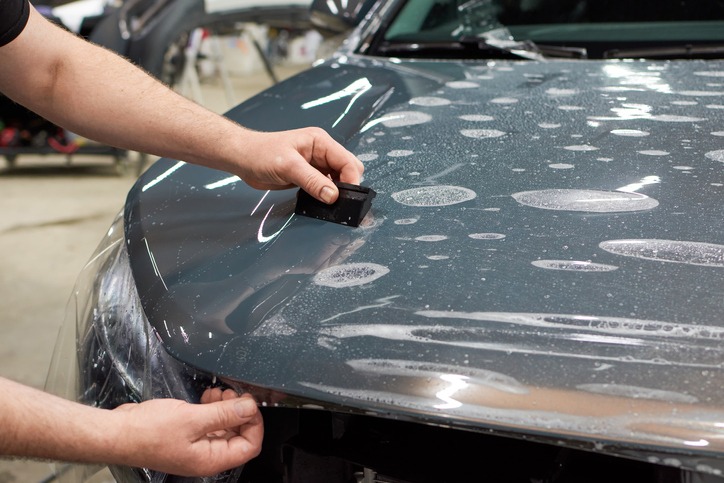There are many things to consider when you purchase a new car. One of the decisions you may have to make is whether or not to install a clear bra, commonly known as paint protection film (PPF).
PPF is a clear urethane film that is applied to the paint of a car to protect it from chips, scratches, and other types of damage. This film acts as a barrier between your paint and the outside world and can help to prevent scratches, swirl marks, and other forms of wear and tear.
However, there are some drawbacks to PPF as well. For example, the film can yellow over time, and it can be difficult to remove if you ever decide to go back to the original paint job. This article will discuss extensively the pros and cons of a paint protection film installation on a new car.
What is a Paint Protection Film(PPF)?
Paint Protection Film is a transparent polyurethane-based substance that can be applied on paint surfaces or other materials to protect them. It is an elastomeric polymer film made to protect the paint source from damaging substances, UV rays, minor scratches, and road debris.
It offers a long-lasting gloss sheen that enhances the beauty of your car in addition to protecting the surface from minor scratch marks.
The material has excellent mechanical properties, including high strength and flexibility, low rigidity, high chemical stability, and high resistance to UV damage.
When you put it on top of your car, it acts like a second skin, preventing the paint from being worn away by the sun and other environmental factors like salt and acid rain.
There are different brands of Paint Protection Films on the market, and they all share certain key features. The film is typically clear or slightly tinted, and it is applied using a wet process that allows it to bond directly to the paint.
Most films are also treated with an ultraviolet (UV) inhibitor to help protect against fading. When properly cared for, a good quality Paint Protection Film can last for many years.
Advantages of Paint Protection Film
There are several advantages of installing PPF on a new car. Some of these include:
Protection Against Damage
The film acts as an excellent barrier between your paint and the outside world. This means that it will protect your car against chips, scratches, and other types of wear and tear. Additionally, PPF is also resistant to UV rays which can cause fading in some paints over time.
Increased Resale Value
PPF can help to maintain the appearance of your car and preserve its value when it comes time to sell. It can also be used to add a glossy finish to your car. This is because the film has a shiny and reflective surface that will make your car look brand new.
Durability
The urethane film is much more durable than paint, meaning it will last longer and provide better protection against chips and scratches. This will help to keep your car looking good for longer.
Cost
PPF is relatively inexpensive when compared to other forms of paint protection such as ceramic coating or waxing. The cost of installation and materials are also much lower than they would be with a full-coating job.
Easy to Clean
Since PPF is non-porous, it is much easier to clean than regular paint. This means that dirt, mud, and other debris won’t stick to the film as easily. This makes it easier to keep your car looking clean and shiny.
Quick Installation
Additionally, it is a relatively quick and easy installation process that can be done at almost any body shop or garage. This means you can have your paint protection film installed in a matter of hours.
Little Maintenance
PPF requires minimal maintenance and upkeep. All you need to do is wash it regularly, and you won’t have to worry about waxing or polishing.
Disadvantages of Paint Protection Film
Despite the many advantages of PPF, there are also some drawbacks to consider.
Difficult to Remove
If you ever decide to go back to your car’s original paint job, PPF can be difficult to remove. It is not a simple process and can take several hours depending on the size of the area.
Yellowing
The film can yellow over time due to exposure to UV rays and other environmental factors. This can take away from the aesthetic of your car and may require replacing sooner than expected.
This discoloration can affect the appearance of your car and detract from its resale value.
Cost
Although PPF is relatively inexpensive, it is still not cheap. You will need to factor in the cost of installation as well as the materials when making a budget for this project.
Tearing/Peeling
The film is also susceptible to tearing or peeling away from the surface of your car due to exposure to water or debris. This could lead to further damage and may require professional repair to fix it correctly.
In addition, bad installation from installers that do not have the necessary experience or skills to do a good job could also lead to the bubbling or peeling of the film over time.
Conclusion
Though there are a few cons to installing PPF on new cars, the benefits outweigh the drawbacks. While it can be expensive, PPF offers ultimate protection against the wear and tear of everyday driving, as well as environmental factors such as sun damage, scratches, chips, dirt, debris, and more.
The durable film can be applied to any car surface – hoods, bumpers, side mirrors, windshields – and will last up to ten years with good maintenance practices in place.
Ultimately, installing PPF on a new car is an investment that has many benefits, and one that you will be glad you made. Now is the time to take advantage of this great protection and keep your car looking its best for years to come!

